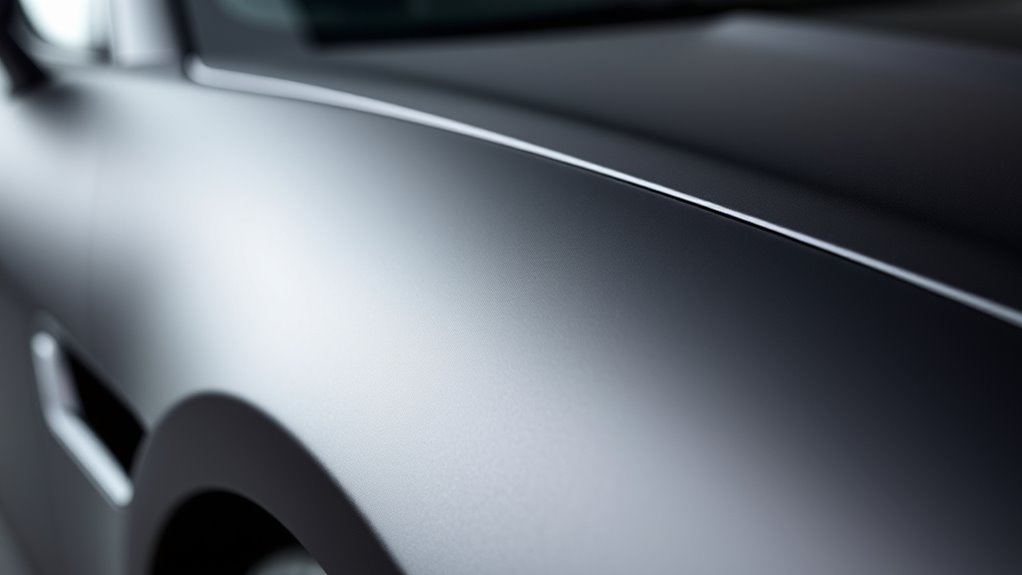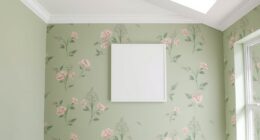To achieve a matte paint finish, start with proper surface prep by cleaning and priming the area. Use high-quality rollers or brushes for even application, applying multiple thin coats for a smooth, velvety look. Be aware that matte finishes hide imperfections but may stain more easily and require careful maintenance. Choosing the right texture and technique can enhance your space’s aesthetic. Keep exploring—there’s more to learn about mastering this sophisticated finish.
Key Takeaways
- Matte finishes hide imperfections and create a soft, sophisticated look but may be less durable and harder to clean.
- Proper surface preparation and primer application are crucial for achieving an even, smooth matte finish.
- Use high-quality rollers or brushes for a uniform coat; spray application can provide seamless results on larger surfaces.
- Matte paints are more prone to fingerprints and stains, requiring careful maintenance and sealing for longevity.
- Selecting the right texture and applying multiple thin coats enhances aesthetic appeal and durability of the matte finish.

Have you ever wondered why matte paint finish is a popular choice for both interior and exterior surfaces? The answer lies partly in its unique texture options and the variety of application methods available. Matte paint offers a smooth, velvety appearance that can soften the look of any space, making walls feel more inviting and sophisticated. When it comes to texture options, matte finishes provide a non-reflective surface that effectively hides imperfections, such as uneven walls or minor blemishes. This quality makes it especially appealing for rooms where you want a cozy, understated vibe without drawing attention to flaws. Additionally, matte paints come in various textures, from ultra-flat to slightly plush, giving you flexibility to match your desired aesthetic—whether you want a subtle, smooth finish or a more tactile, textured look.
Matte finishes hide imperfections with a smooth, velvety, non-reflective surface.
Choosing the right application method is vital to achieving that perfect matte finish. You typically start with proper surface preparation, ensuring walls are clean, smooth, and free of dust or grease. When applying matte paint, most people opt for a roller because it covers large areas quickly and produces an even coat, perfect for achieving that uniform, velvety appearance associated with matte finishes. For edges and corners, a high-quality brush can help create clean lines without streaks. Some advanced techniques involve using spray guns for a more seamless, professional look, especially on larger projects or exterior surfaces. No matter the method, applying multiple thin coats rather than a single thick one guarantees better adhesion and a more refined finish. Keep in mind that matte paints tend to be more forgiving of brush or roller marks, but careful application still results in a cleaner, more polished look.
One thing to remember is that application techniques can vary depending on the surface and the specific product you’re using. For example, textured surfaces might require special primers or a different roller nap to ensure proper coverage. If you’re aiming for a uniform matte appearance, consider using a high-quality primer designed for matte paints, which helps prevent uneven absorption and enhances durability. When applying, always work in well-lit conditions to spot any missed spots or uneven areas. Also, be mindful that matte finishes are more prone to showing fingerprints and stains, so proper application and sealing can help maintain its pristine look over time. Additionally, choosing the right drivetrain components and shifting techniques can help prevent unwanted wear and ensure smooth operation of your bike, especially if you plan to ride on varied terrains.
In essence, understanding your texture options and applying the paint with the right techniques can make all the difference in achieving a stunning matte finish. It’s about selecting the right tools, preparing your surface thoroughly, and applying the paint carefully to bring out the best in your space.
Frequently Asked Questions
How Long Does a Matte Paint Finish Typically Last?
A matte paint finish usually lasts around 3 to 5 years, but durability depends on factors like location and usage. To prolong its lifespan, you should follow maintenance tips such as gentle cleaning with a soft cloth and avoiding harsh chemicals. Keep in mind that matte finishes may show scratches or stains more easily, so regular upkeep is vital. Proper care ensures your matte paint stays vibrant and attractive longer.
Can Matte Paint Be Used on Outdoor Surfaces?
Think of matte paint as a chameleon—adaptable but needing the right environment. Yes, you can use it on outdoor surfaces, but focus on its outdoor durability and weather resistance. Choose a high-quality, exterior-grade matte paint designed for weather extremes. Proper prep and sealing enhance its longevity. When applied correctly, matte paint can withstand the elements, providing a sophisticated, understated look that endures outdoor challenges.
Is Special Cleaning Required for Matte Finishes?
Yes, special cleaning methods are needed for matte finishes. You should use a soft, damp cloth or gentle cleaning solutions to avoid damaging the surface. Avoid harsh chemicals or abrasive scrubbers, as they can dull or stain the finish. For maintenance tips, regularly dust the surface and clean spills promptly. These careful cleaning methods help preserve the matte look and keep your surface looking fresh and smooth.
How Do I Fix Scratches on a Matte Painted Surface?
You notice a scratch on your matte painted surface—don’t panic. Start with gentle scratch repair by cleaning the area, then use touch-up techniques with a matching matte paint or a matte finish marker. Lightly blend the repair with a soft cloth, avoiding shine. For deeper scratches, consider applying a matte clear coat to restore uniformity. With patience, your surface can look flawless again, hiding the damage effectively.
What Are the Cost Differences Between Matte and Gloss Paints?
You’ll find that matte paints generally cost less than gloss paints, mainly due to differences in application and finish. Matte paints typically require fewer coats and less preparation, reducing overall costs. In contrast, gloss paints often need more precise application and multiple coats for a smooth finish, which can increase expenses. The cost comparison varies depending on the quality and brand, but generally, matte paints are more budget-friendly and easier to apply.
Conclusion
Achieving a matte paint finish can truly transform your space, offering a sophisticated, modern look. Imagine a homeowner who chose matte walls for their living room, only to find that the soft, velvety surface hides imperfections beautifully, creating a cozy, inviting atmosphere. While it requires careful maintenance, the stunning, understated elegance it brings makes it worth the effort. With the right techniques, you can enjoy a flawless matte finish that reflects your unique style and personality.









